|
| | The Annunciation, Part II |
|
|
| A Curious Obsession |
Following our visit to Florence in 2017, we posted a Photo
Page, The Annunciation in Renaissance Art, showing a series
of paintings of the imagined notification to the Virgin Mary of her role as mother to Jesus.
It was a very popular subject during the Renaissance. The page gave our
uninformed "tourist" review of each work, as well as trends and styles we noticed among the roughly
thirty examples we encountered. During our travels since, we have continued to encounter Annunciation
paintings, by both European and North American artists. For example, at the National Church in Copenhagen DK,
we encountered this spectacular mural:
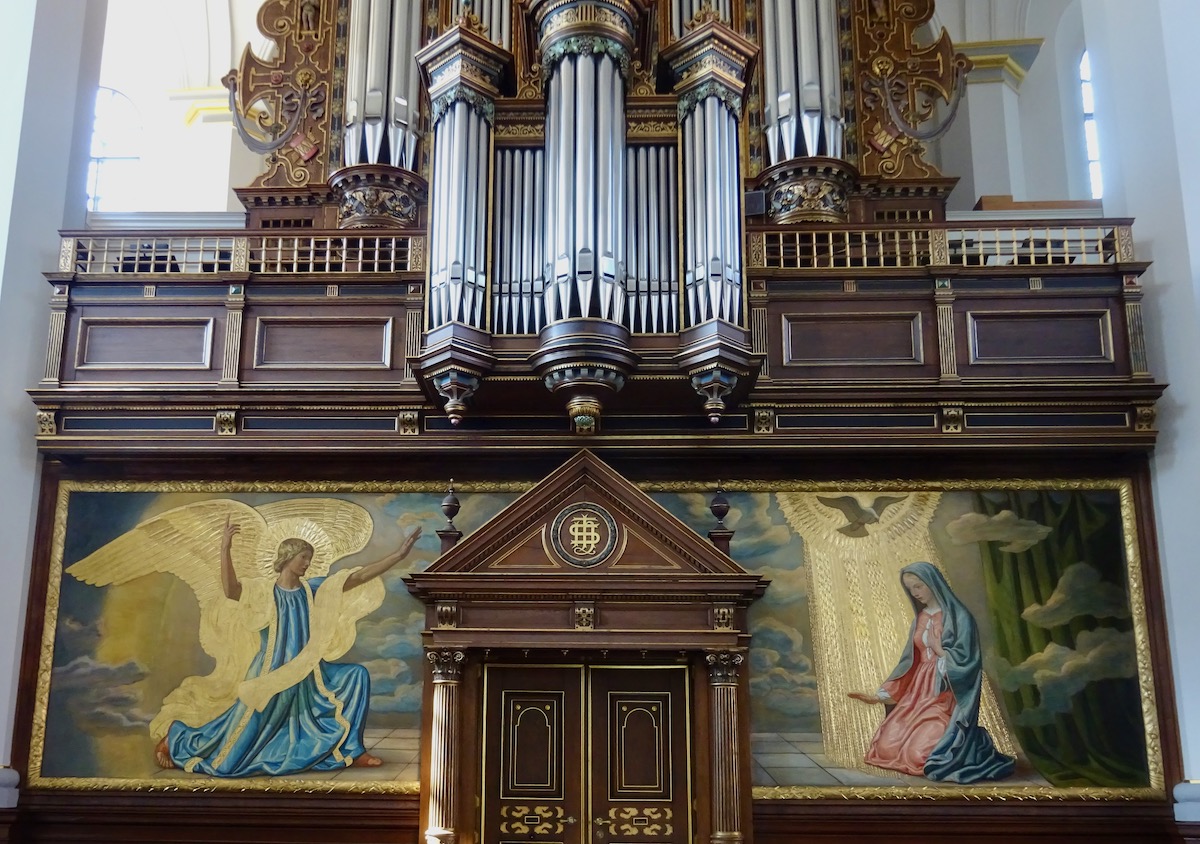
The massive size has allowed the artist to render Gabriel and
Mary so that
we perceive the epic nature of his message, and her realization of the responsibilities it places on
her shoulders.
Being unable to throttle our compulsion,
we have dutifully recorded those recent works. Unsurprisingly, perhaps, modern painters have taken many
more liberties with the idea, producing fascinating paintings. Consider our more recent discoveries.
| |
|
| The Story |
According to Christian tradition God sent the angel Gabriel to announce to the Virgin Mary that she would conceive
and become the mother of Jesus. She is at home, reading when the angel arrives.
The scene is underspecified in the Bible, so artists must interpret it.
In addition to Mary's home and her book, they sometimes
include additional angels, a dove, a lily in Gabriel's hand, and lines or rays from heaven towards
Mary, presumably implementing the conception. In almost all cases they imagine Gabriel
on the left, Mary on the right, and she wearing a red dress with a blue cape.
|
|
|
| Rennes France |
Three works caught our attention at the Musée des Beaux-arts de Rennes, the premier art museum in
Rennes France, capital of Brittany. |
|
|
| Unknown |
Little information was available about this very old (and damaged)
painting of the Annunciation. Standard features - red dress, blue cape, Gabriel heralding the news -
are present, but others are not. The two figures are aligned nearly vertically rather than left-to-right.
Was Mary reading or has she been doing handwork as
suggested by the fabric in the basket? Either way, she's overcome by the news and possibly distressed by it.
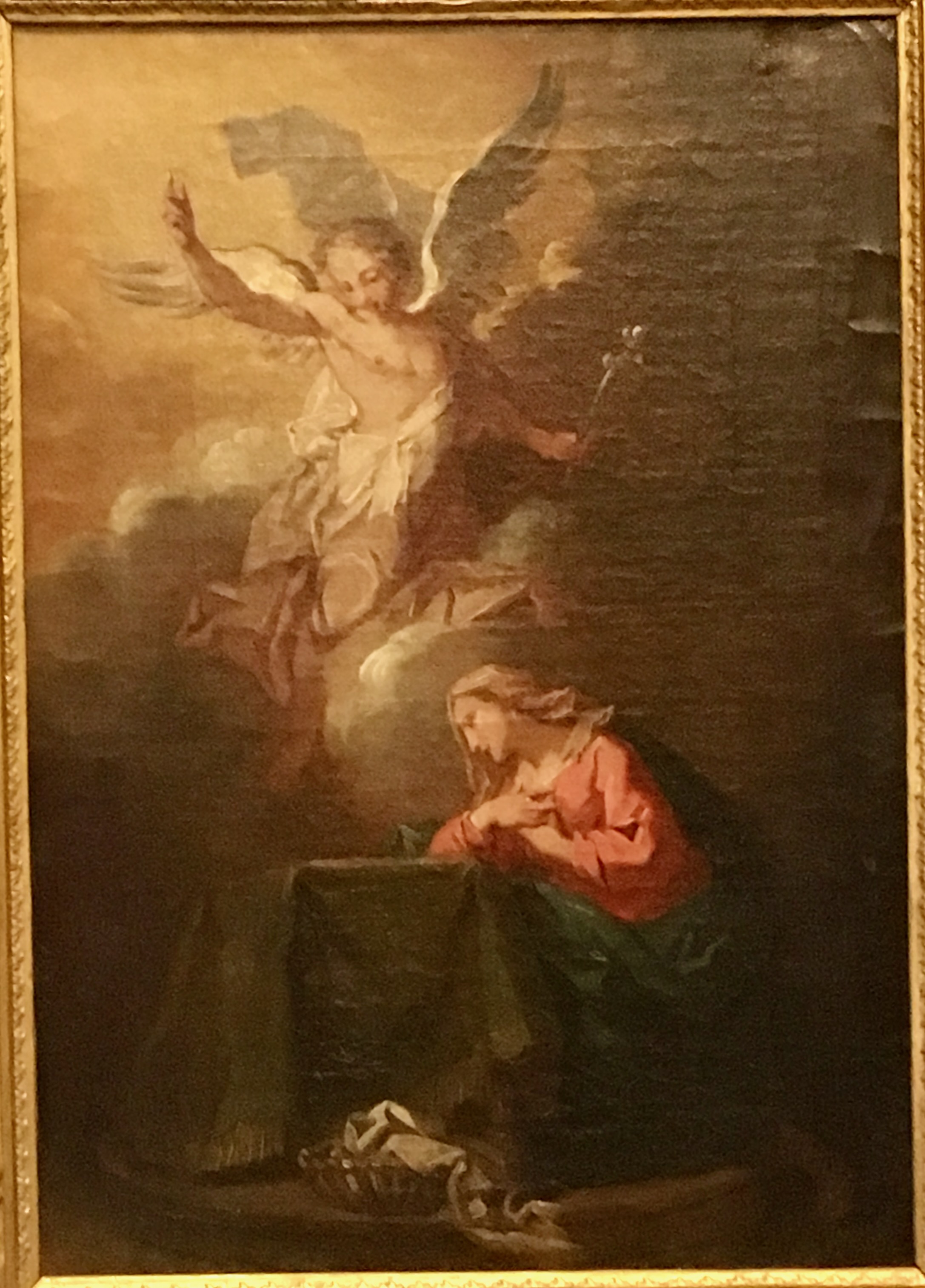
|
|
|
| Unknown |
Our poor photograph of a second Rennes museum Annunciation shows Mary's extreme
reaction to Gabriel's announcement. She seems to be more in ecstasy than in shock. Gabriel's subdued colors,
body position and perch on a cloud suggest he's an Observer rather than an Announcer, implying
the artist sees the moment as less about anticipating future events and more about the event itself. The prominent
dove and the aura surrounding it support this interpretation. Finally,
the artist poses Mary to the left and Gabriel to the right, further separating this work from the traditional
Annunciation.
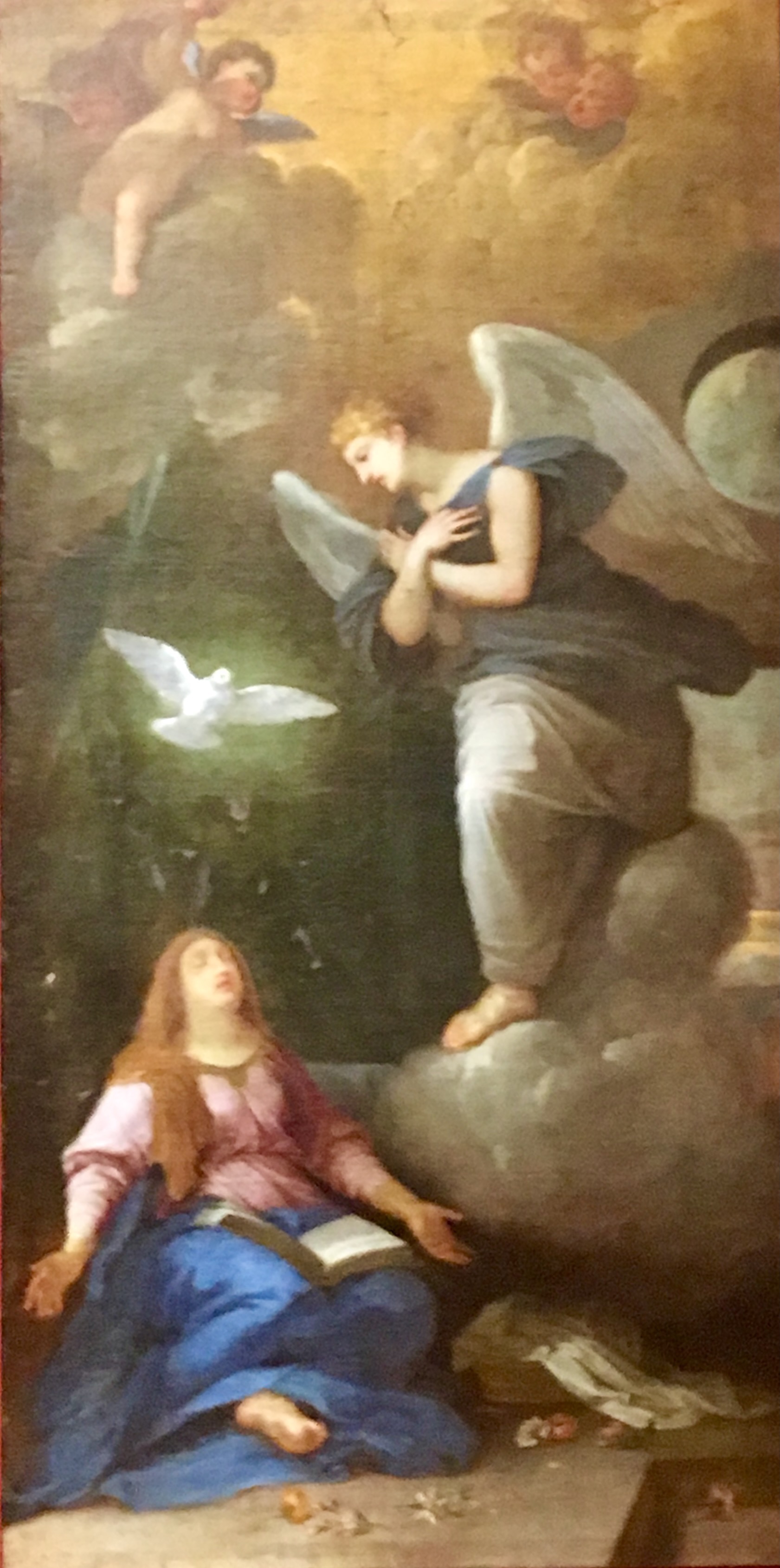
|
|
|
| Plagerist |
Rennes's Modernism exhibit displays a graphic from the early years of digitization. The artist used magenta half-tone dots to
render a monochrome image of perhaps the most famous of the Renaissance paintings on this topic, Fra Angelico's
fresco The Annunciation. The point of
copying a famous painting using a basic printing technique is unclear. The technique only preserves the relationship between light and dark, though
the painting is still identifiable and its principle components are
recognizable. Everything else in the masterpiece has been obliterated. Maybe Magenta Man's point is Fra Angelico worked too hard on shading and detail,
though the effort produced a painting we all prefer.
Curiously, we would know it is a Fra Angelico Annunciations even if it wasn't so famous, because no other Renaissance artist, painted Mary with her arms folded.
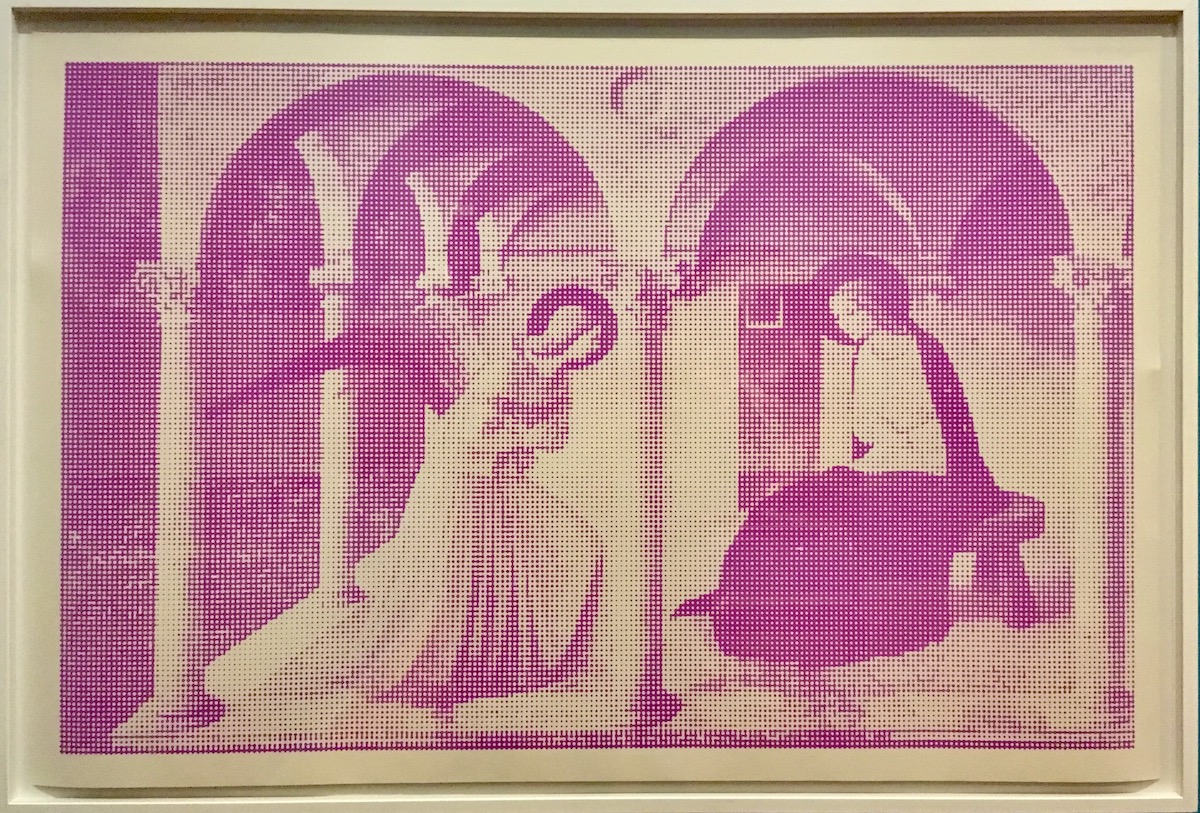
|
|
|
| Travelling |
Other examples of the Annunciation have popped up here and there in our travels. These are interesting, though we haven't always
recorded which museum owns them. |
|
|
| Jean Hey |
Painted around 1493 by Jean Hey, this masterpiece breaks with tradition in several ways. Most obviously, Mary and Gabriel are looking past each other.
This is explained because this Annunciation was painted as the extreme left frame of an alter piece, and thus a component of a larger design. So it is
mostly an odd feature of this painting. Mary has flipped her color choice for the dress/cape. Also, Hey shows Gabriel as having fully entered Mary's
bedroom. Artists at this time often accorded Mary more privacy, limiting Gabriel to the doorway; in the extreme, Botticelli in his fresco
kept Gabriel at the back of the adjacent room. Finally, Mary seems to be quite
impassive at the news. "Whatever."
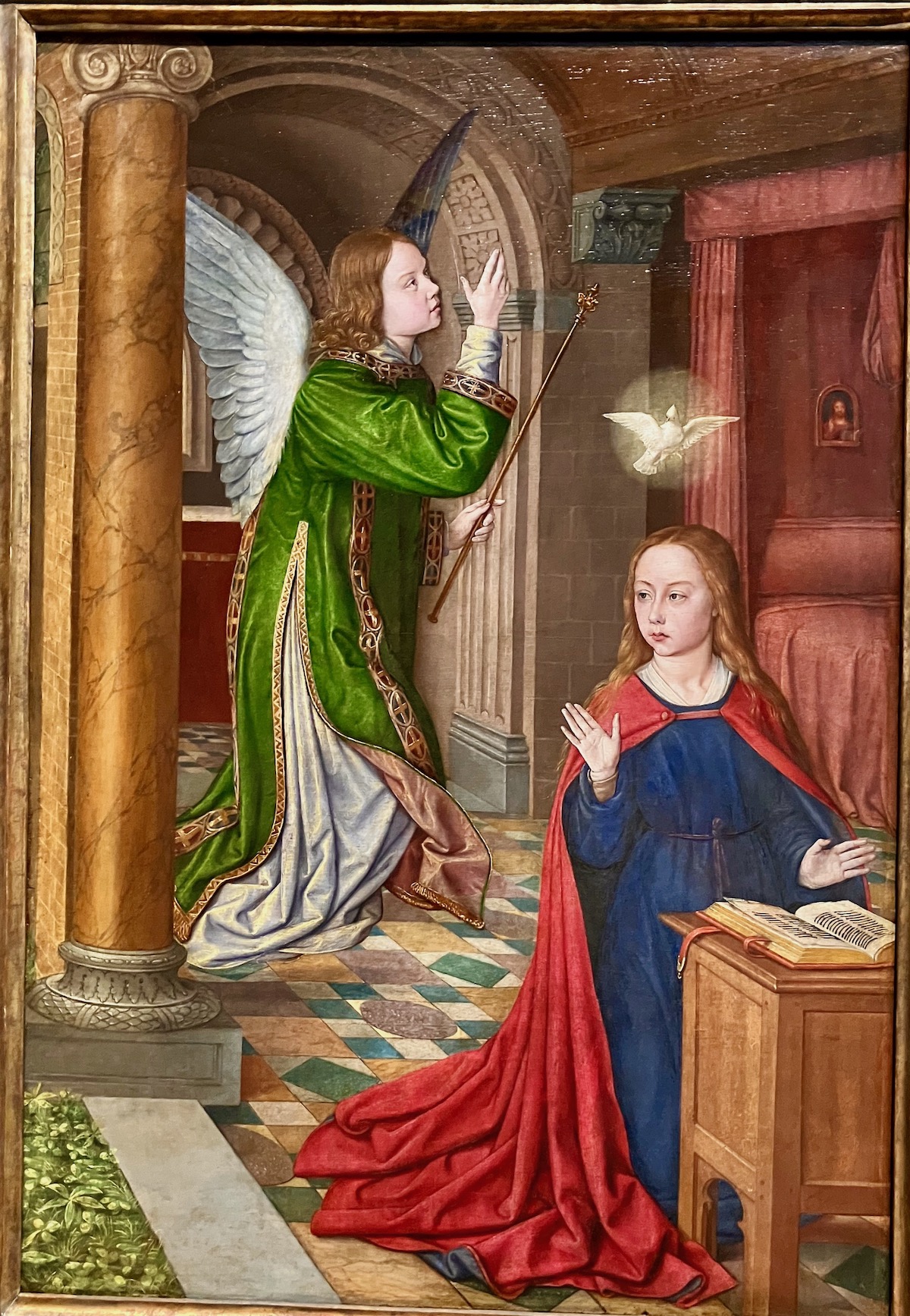
|
|
|
| D'Antiphonaire |
Painted about 1500 by Feuillet D'Antiphonaire, this elegant painting finds Mary reading in her room, though she has chosen to relax in a matching cape.
Gabrielle appears to be not so much announcing as lecturing: "Remember to take your vitamins." FD'A's advancement is to center the dove in
the arched window showered by rays from heaven.
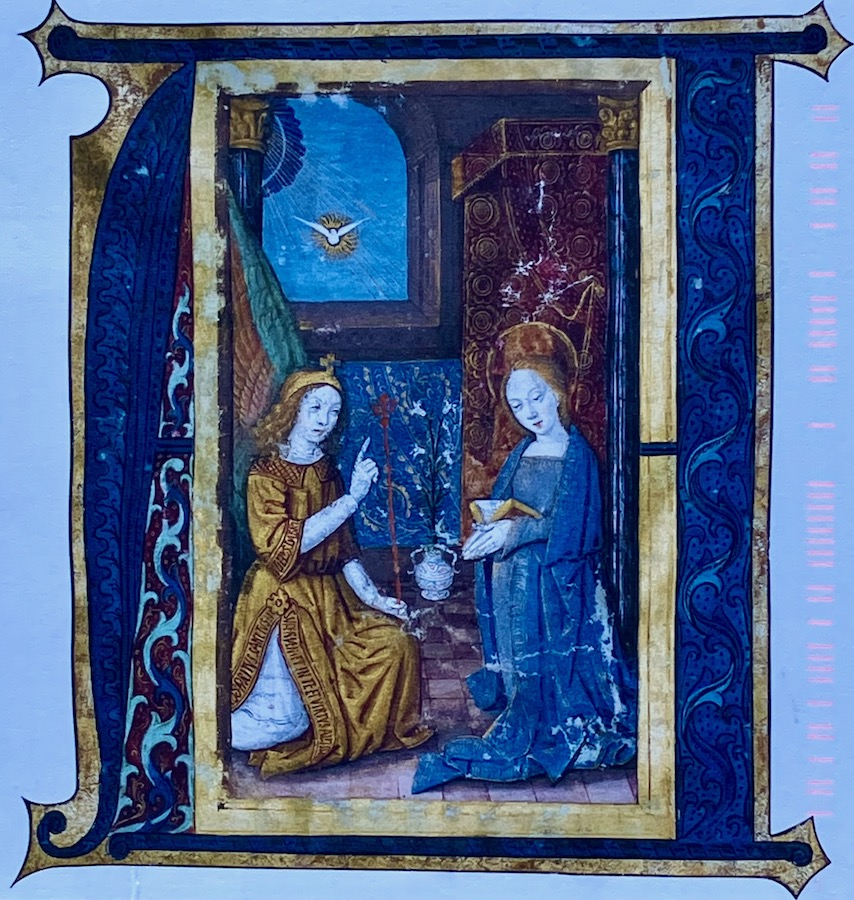
|
|
|
| Arthur Hughes |
Moving beyond Renaissance art, we found this creative version of the Annunciation by Arthur Hughes from 1858.
He has taken some liberties. Gabriel's surrounded by lilies, irises and vines, and exhibits an uncharacteristic femininity. He conveys a sense of
concern, doubtless from the shock he's just given to Mary. Hughes presumes she wouldn't be wearing the usual red dress / blue cape ensemble,
preferring to show her in a much more elegant outfit. Further, she hasn't been reading, but spinning. Gabriel's news startles her to the point
of dropping her skein of yarn, shown in mid-fall. And the surprise registers on her face as disbelief.
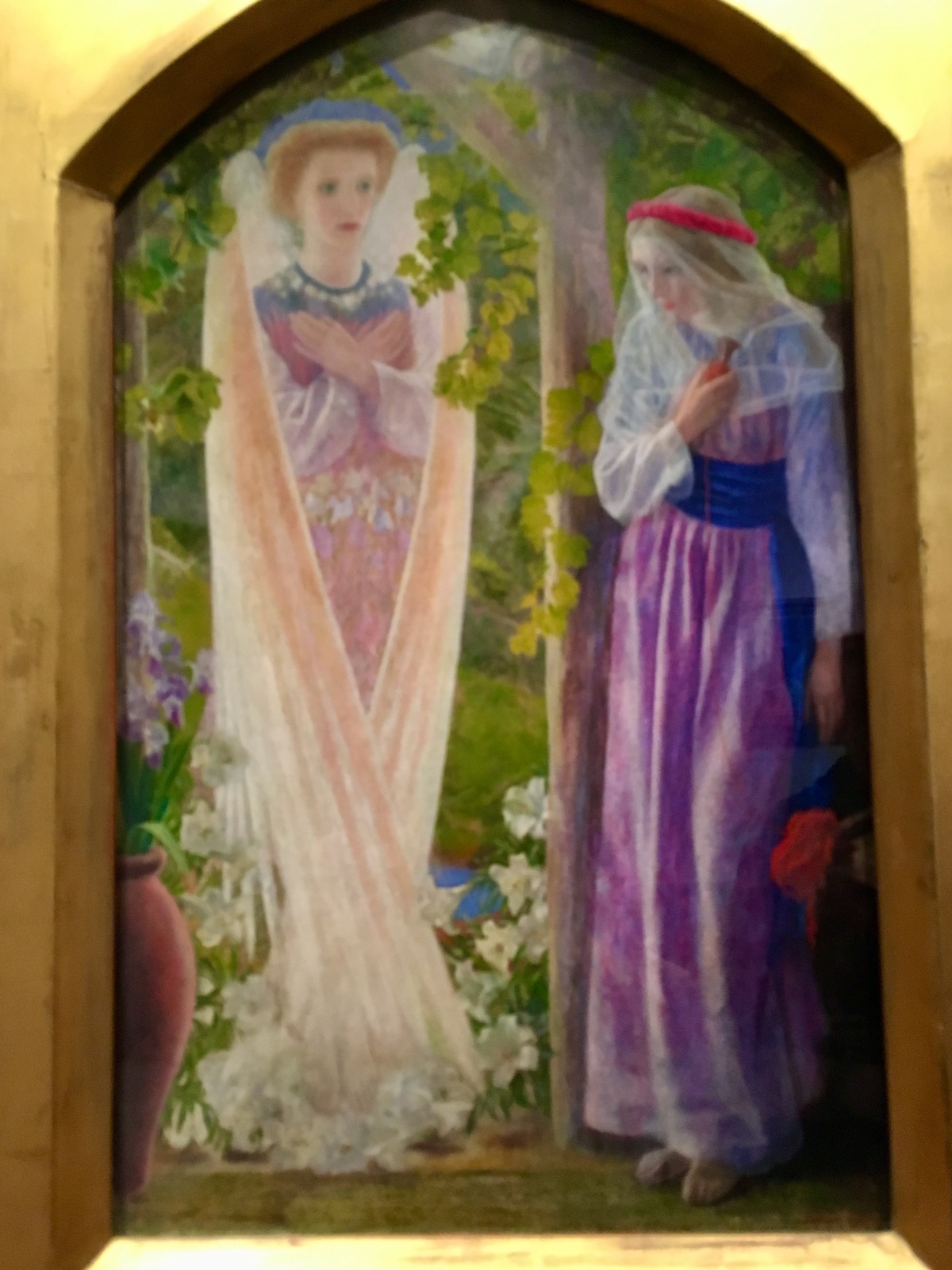
|
|
|
| Unknown |
Not every artist tries to be innovative. This panel, inset in the wall of a church, tells all aspects of the story.
Every component is shown explicitly: reader Mary, Angel Gabriel, lilies, beam from Heaven, dove and even the Hand of God.
The highlights in gold give the story authenticity and eliminate any concern about what color her dress and cape are. The one point
of innovation is the jet-like profile of the dove, shooting out of Heaven.
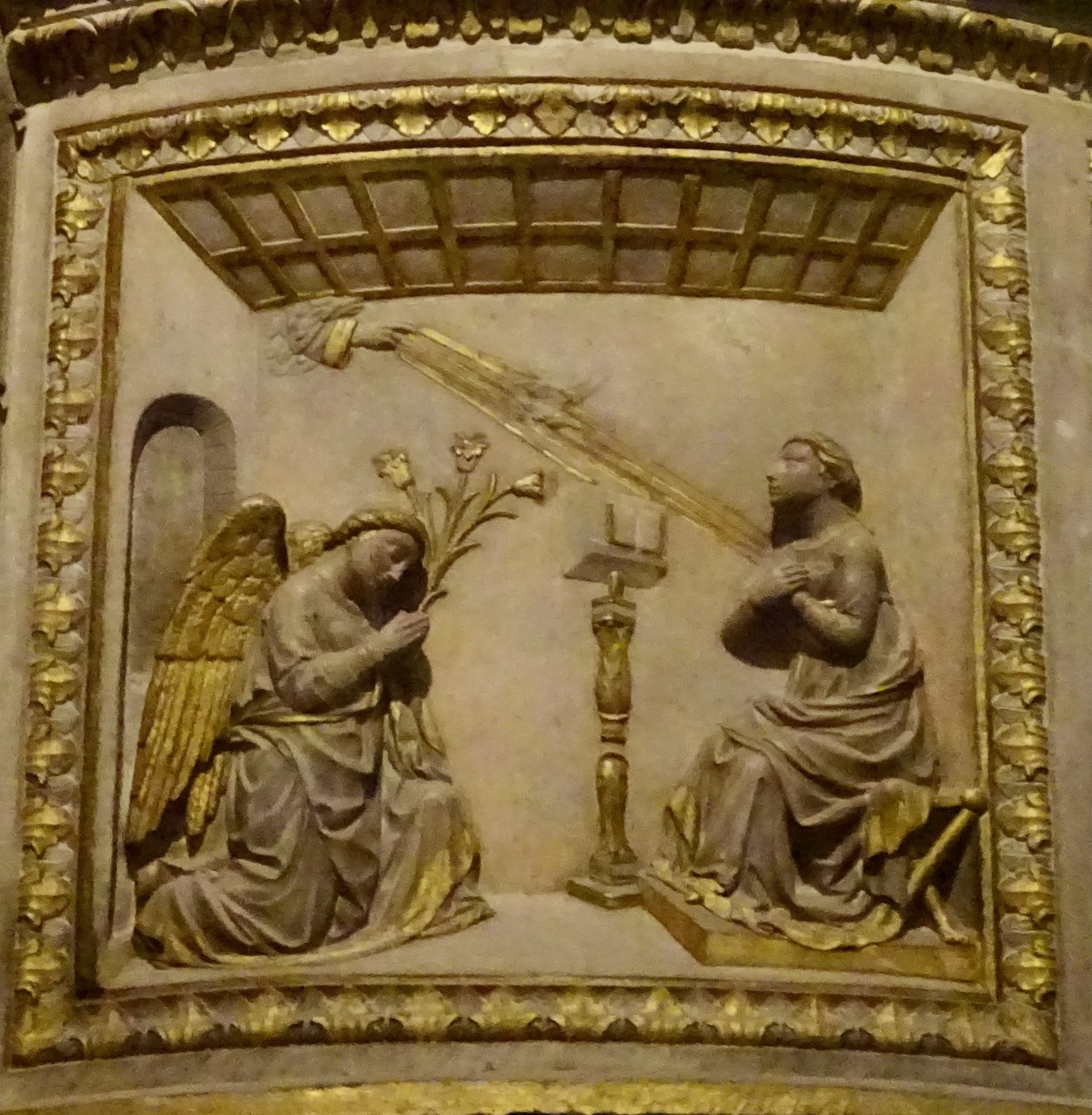
|
|
|
| Unknown |
In a similar "3-D Explicit Style", we found this Annunciation part of a massive
alter (lower left) at Denmark's Roskilde Cathedral.
Again, all features are accounted for, though the Hand of God has been replaced by an attractive cloud. Plus, the cat is a
good addition.
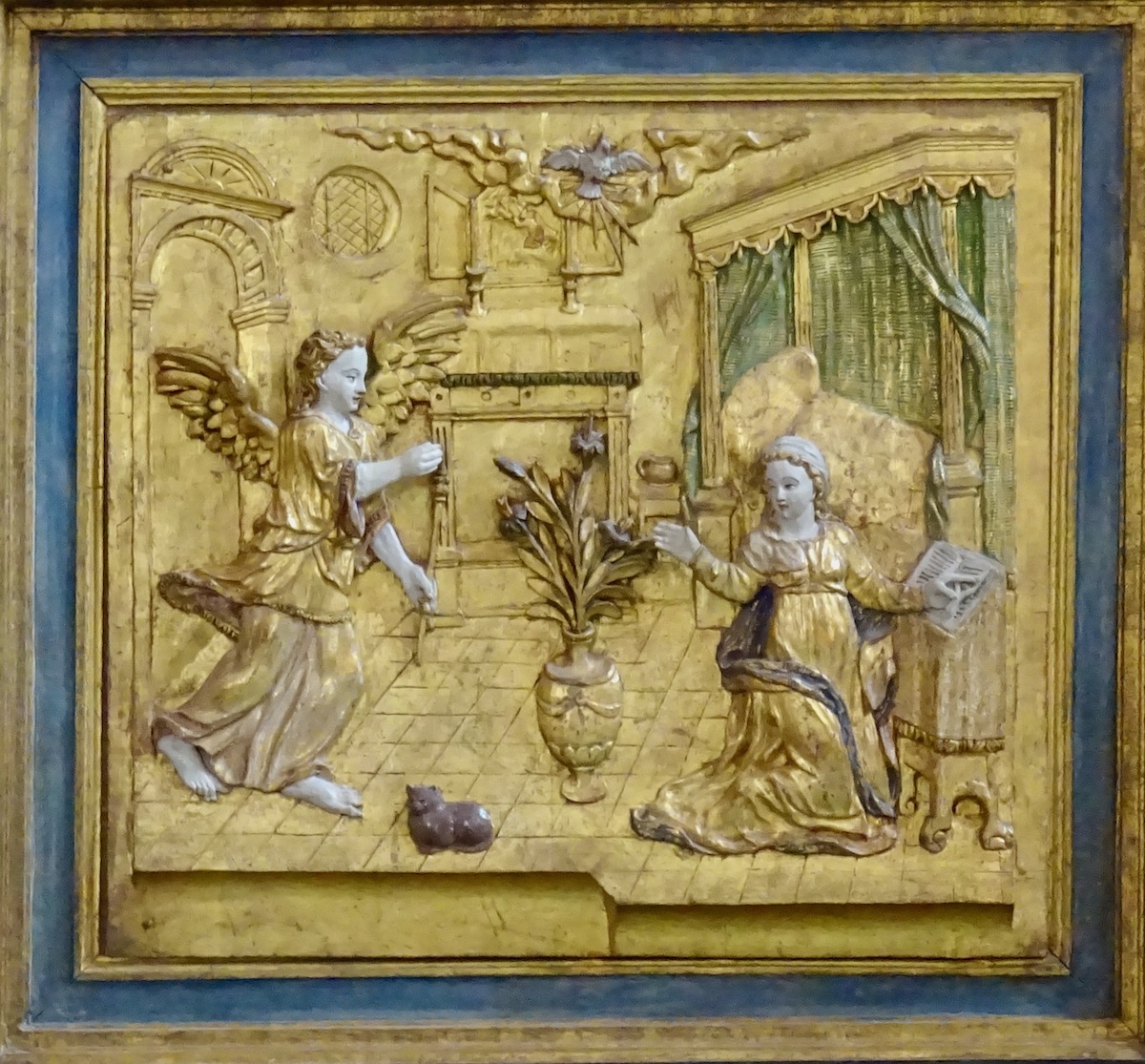
|
|
|
| Art Institute |
The Art Institute of Chicago offers two of the most abstract interpretations we have encountered. |
|
|
| George Hitchcock |
One extreme - near total elimination of explicit mention of the story's components - is
George Hitchcock's 1887 Annunciation. The Dutch peasant girl serves as Mary, and the lilies have traditionally symbolized
Gabriel. Her thoughtful countenance with downcast eyes tells the viewer she's heard Gabriel's news. Apparently a broadcast announcement.
It is a beautiful and beautifully subtle painting.
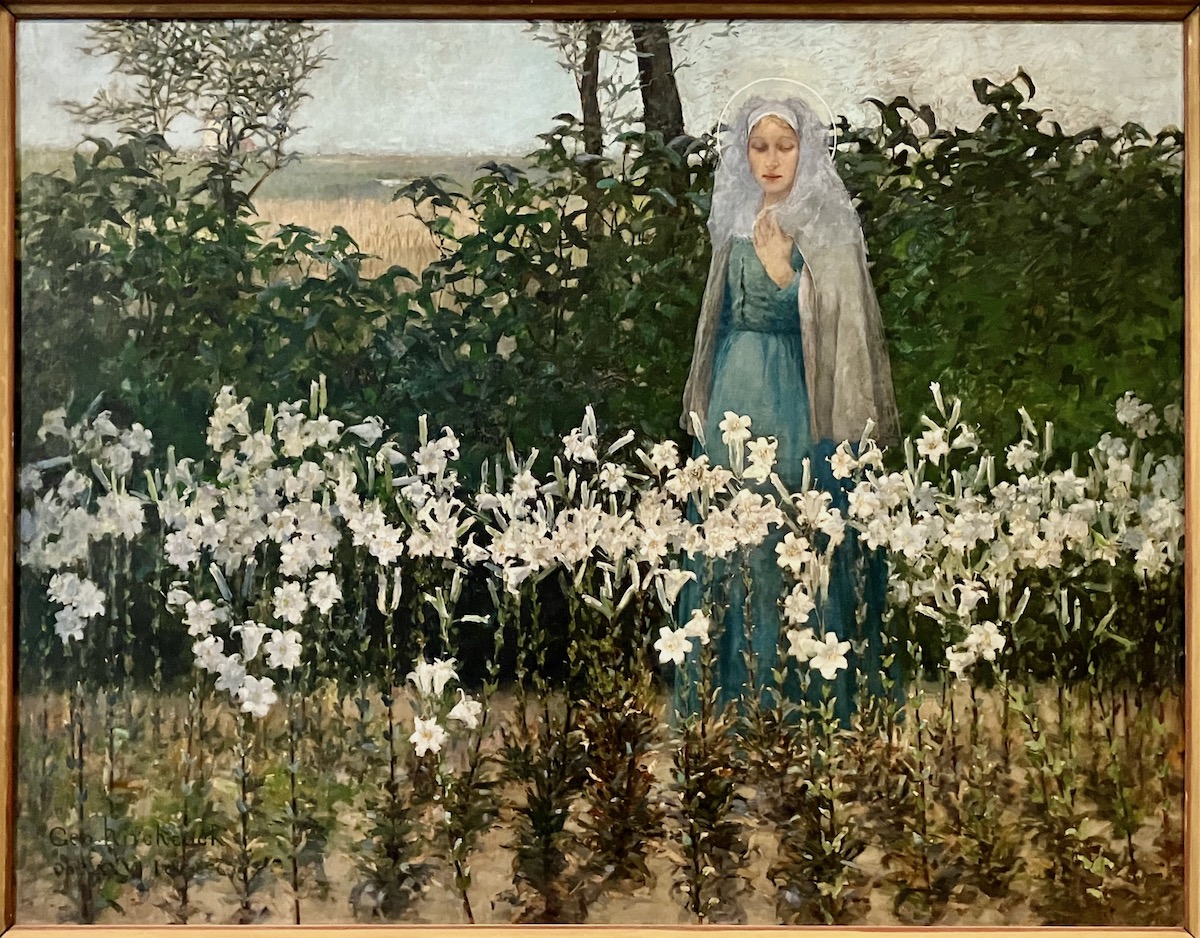
|
|
|
| Jay DeFeo |
If maximally minimal is a concept, then Jay DeFeo's 1957 Annunciation illustrates it. Here we have two
white wings, which according to DeFeo, "announces or promises some realization of all the good in this existence." DeFeo goes on to
explain that the "announcement" motivating the painting was a personal statement about her commitment to creativity. It's very abstract,
but parallels the Annunciation story.
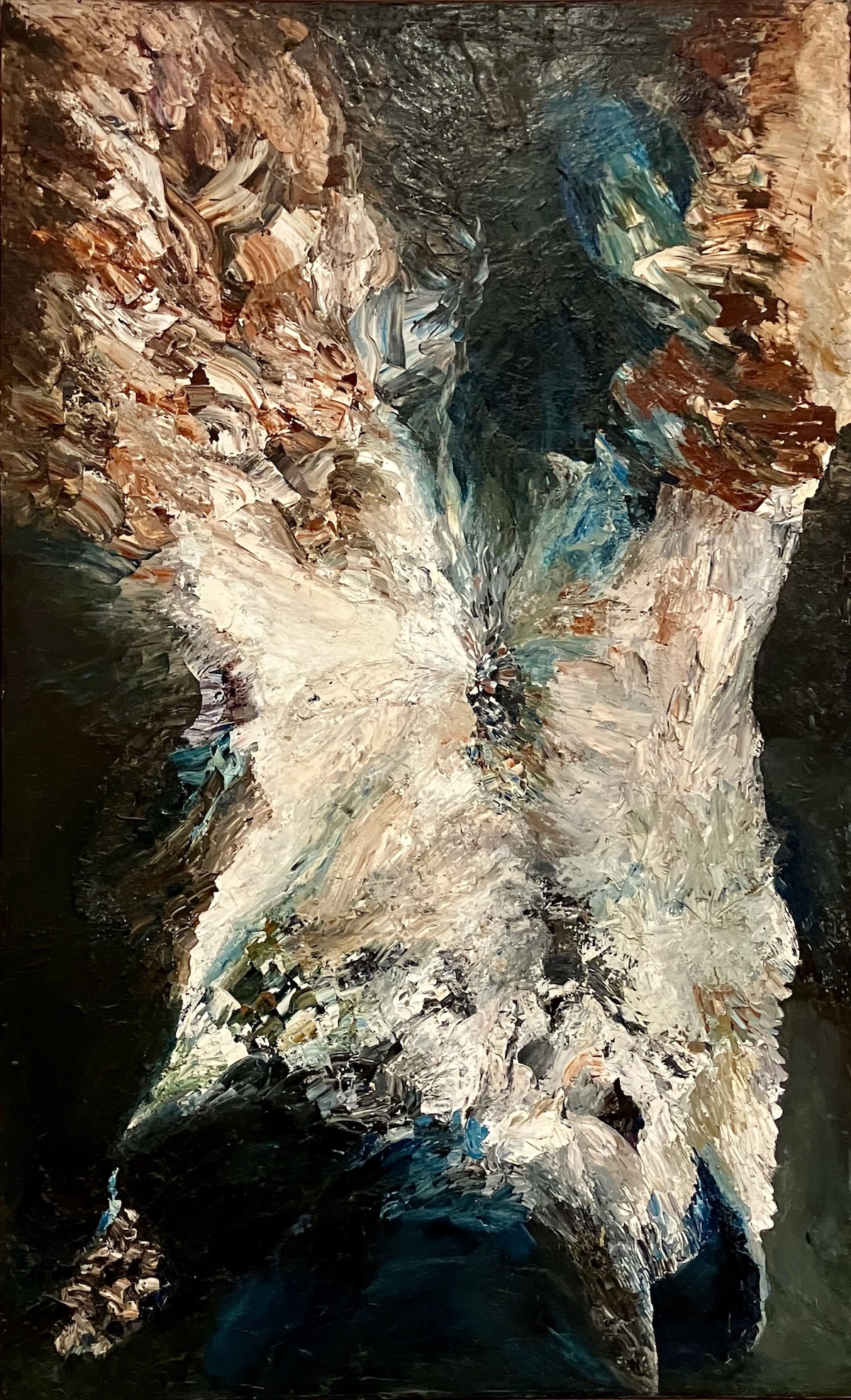
|
|
|
| |